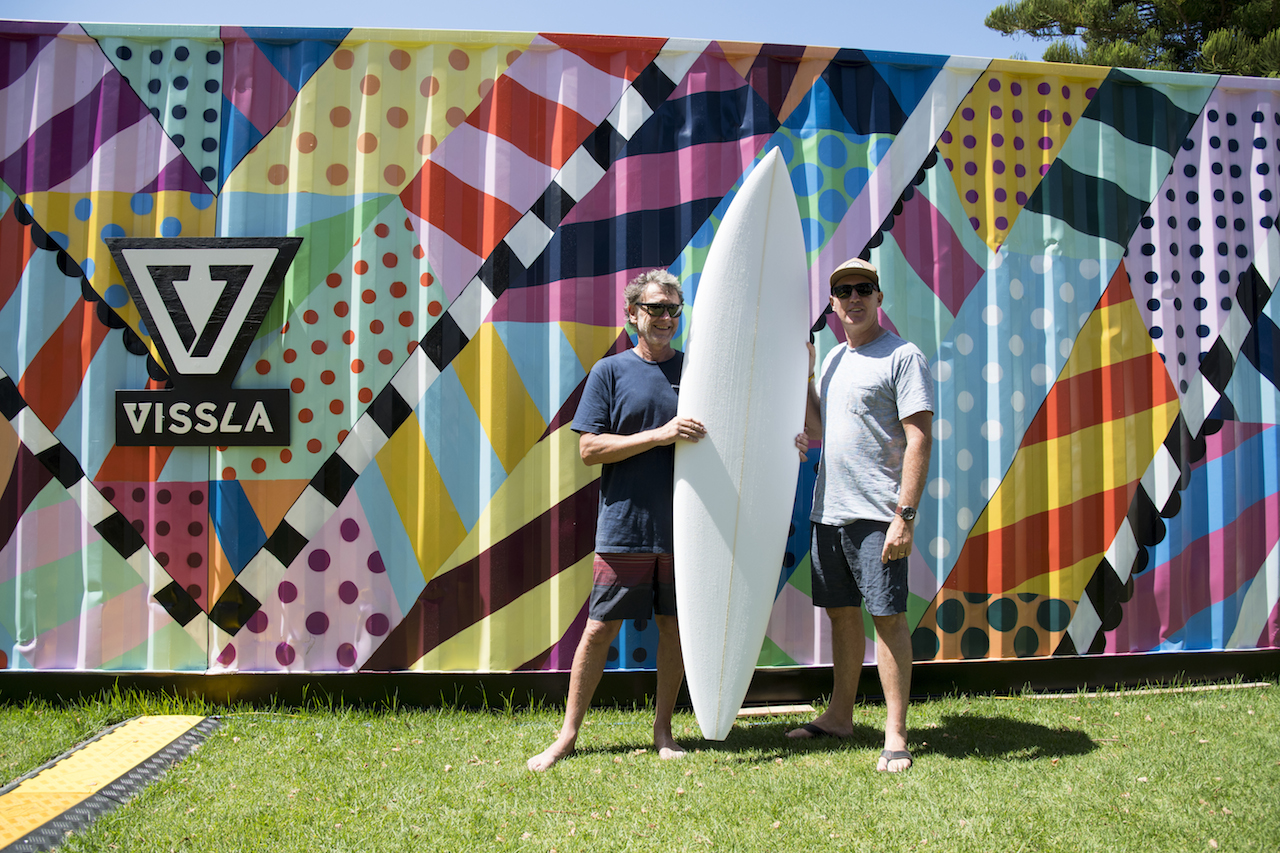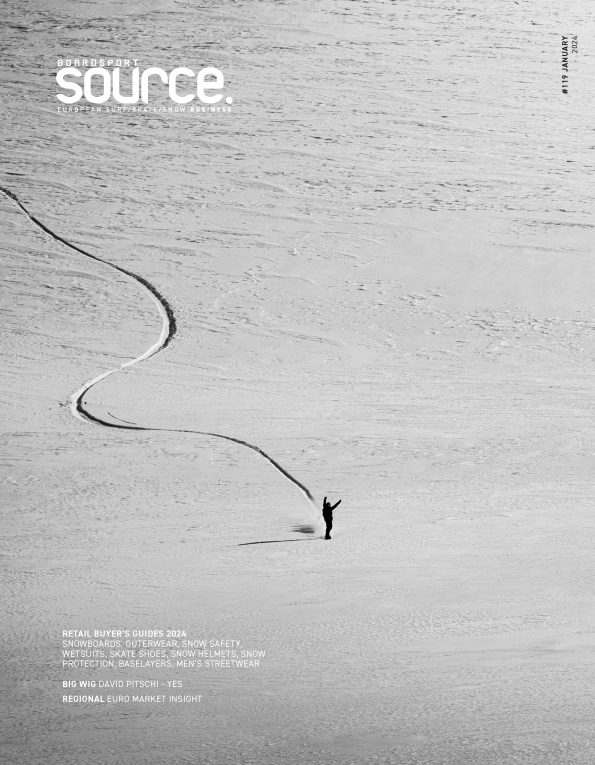
Big Wig Interview: Vissla’s Derek O’Neill
For this issue’s Big Wig we feature a true surf industry veteran in Derek O’Neill. Derek has a rich work/surf history, which saw him start out 30 years ago as a sales rep for Piping Hot wetsuits in Torquay, Australia before opening Billabong’s European office in 1991 before later serving as CEO of the company. In late 2013 former Billabong colleague Paul Naude launched Vissla (and D’Blanc) and Derek took charge of the European business and since then the company has injected some much needed freshness into the surf business. Derek talks us through his biggest lessons learned over the years, biggest influences on his career and the man from Melbourne explains how, through past experience, they’re keeping distribution clean, margins healthy and products sharp.

Derek O’Neill and legendary Australian surfer shaper Wayne Lynch at the Vissla Sydney Surf Pro in Manly Beach Australia
Please can you give us your background.
Growing up in Melbourne, Australia, I had a period working with my father’s plumbing business after finishing school, which soon allowed me to work out what I didn’t want to do! A surfer since the age of 11, I was a competitor in the Australian Surfing Championships in 1986, which was sponsored by Billabong and it looked like the marketing guys were the ones having the most fun. The surf industry around Torquay, Australia was doing well at that time, and I used to spend a lot of time at a local surf shop where I would meet plenty of sales reps who all looked to be having fun, surfing a lot and making money. I became a sales agent for Piping Hot wetsuits in Torquay around 1987 when they were a big player in Australia, and when were acquired, I came to Europe in 1989 with a backpack and a six-month ticket, which ended up being 14 years short. Billabong then asked me to open their first company office in Hossegor in 1991, and I founded Billabong Europe that year. Fast growth followed and we went from zero to $100 million in ten years and from four staff in the first week to over 300 employees. I was appointed CEO of Billabong in 2003 returning back to Australia, finally parting company with the group in 2012 when they decided they wanted a more corporate management team. Vissla started as a discussion late 2013, and I immediately said I wanted to go back to Europe.
Which person within the industry had the most influence on you and why?
Over a long period one person would be a hard pick. But early industry guys like Rod Brooks at Piping Hot, Chops Lascelles in England in the late 80s, Dougall Walker and Bob Hurley at Billabong in the 90s, Gary Pemberton the first Billabong Chairman, and more recently Paul Naude at both Billabong and Vissla have all played important roles in demonstrating what should be done, can be done, and also sometimes what should not be done.
What have been the best lessons you’ve learned in business?
There are many. There is always a baseball bat out there somewhere ready to smack you on the head as soon as you think you know everything. Employ people much smarter than you every chance you can. Have fun. Delegate. You learn a lot more when things are going bad than when things are going well. Then the most important, get the cash in. Get paid as fast as you can. It’s your money and you are going to need it.
Since the word go, Vissla hasn’t been about being the biggest, it’s been about being happy with the level of business you’re doing. Does this mantra still apply?
That still applies. We get retailers wanting to buy 50% more than the previous season but then want a big discount and longer time to pay. It’s like, why would we want to do that? This time around it is us privately funding the business, and at the back we are carefully planning and growing our warehouses, shipping facilities, growing our production capacity, working with suppliers that can grow with us, etc, but we also have to make sure the market grows at the same time and sometimes we are asked to match unsustainable terms that some of our competitors give. A lot of the brands we compete with are losing money or struggling, and we can see that the terms and deals they give out are a big part of that, so we have to say no a lot. If that keeps us smaller than some others in the market, well we can live with that. A lot of stores want a smaller hard to find brand.
The retail landscape is evolving at such a rapid pace, where and how are you hedging your bets?
We are just in our fourth year now. We are a surf brand, but feel a little different than some of the other brands in our sector. While we can see retailers under pressure, we want to work with them to sell our products at or close to full margin, by keeping our points of distribution as clean as we can, and not competing against them by doing mass online clearance sales on our site or Amazon or others. Most of our clients have strong sell-through results out of store.
How has it been different building up Vissla compared to building up the Billabong brand, given that they were founded in different decades?
The basics on product, logos, athletes, events, company ethos etc have not changed much over time, but how you tell it to the surfer has changed drastically. Decades ago, the communication from the brand would have to go through the retailer, in how the product was presented in stores, or through the boardsport media in mostly monthly surf magazines, and it would take months to come out. Today the most important communication line is from the brand straight through to the end user, and it is immediate.
Do Vissla take a global approach, or are certain/all parts of the business regional?
Most of it is global with a few small adjustments in marketing and product. But we figure that key products like boardshorts and wetsuits will work in most regions and do not need a lot of tinkering.
Where are you at with Vissla retail units in Europe and what does the future footprint look like?
Retail is only a small part for us, and what we do have sits mostly around Hossegor where there are almost no multi-brand retailers, only company branded stores. We have three currently just out of town with one licenced store just opening in the centre of Hossegor for summer 2018.
Boardshorts and apparel were your key offerings initially, but it’s safe to say Vissla wetsuits have made a huge impression on surf retail. Why do you think that is?
Wetsuits have been really a lot of fun to develop. In Europe they are our main tech product that is worn all year round, whereas boardshorts are limited to 2-3 months and not wearable in the surf in all European countries either. We offered an alternative to the other guys, we had a good mid level priced suit range, the suits are really using great materials and are well built and we deliver on time! A lot of guys rip but maybe don’t want to wear a big brand suit, and so we get a lot of really strong local surfers wearing our wetsuits.
Millennials and how to market to them: What have been the biggest lessons learned in marketing since the start of the brand, what have been the highlights and where are you placing marketing credence going forward?
Years ago a typical surf brand would do maybe one big movie every two/three years, then do some smaller clips for showing in stores, so maybe 5-8 per year. At Vissla we release around 150 digital clips/movies per year, some 30 seconds, some up to 25 minutes, and we also give them to our retailers to use on their digital feeds. Brands have to tell stories. It’s the same with photos; we have some amazing shots from our very creative surf team, and have been promoting shapers as well since the beginning. Recently we stepped this up big time with the Vissla Sydney Surf Pro at Manly and this featured a WSL 6000 surf contest for both the males and females, plus we had an amazing five days of some of Australia’s best surfboard shapers doing their thing on the beach in public. We embrace innovation and creativity in surfboards, and we try to promote those shapers giving them a lot more diverse exposure than they normally get.
What’s the biggest challenge the surf industry currently faces and why?
Since surfing product began, there have been quite a few industry cycles of the distribution being pushed too far and wide. What this can mean – and some brands have been through this cycle with mixed results and some are still going through it – is new brand owners are coming in from other industries that do not have that historic knowledge and some of them are going to learn the lessons of the past. Retailers will need to be open to everything; many retailers are only in place because of deals from brands, because for some brands it is becoming clear that the independent surf retailers may not be that important in the future. Surf retailers will increasingly need to concentrate on selling what their customer wants rather than offering the product they got on the best deal. That is going to lead to floor space opportunities and I think we are well placed to pick up some of that. We all need retailers to showcase creativity and authenticity in the market. I personally think the next five years will be great for the industry as a whole.




